Japan
Wood Products Prices
Dollar Exchange Rates of 25th
Aug
2024
Japan Yen 144.37
Reports From Japan
Rise in personal consumption lifts growth
Japan's economy expanded at a much faster-than-expected
annualised 3.1% in the second quarter, rebounding from a
slump at the start of the year. Capital investment increased
by 0.9 percent, and housing investment was up by 1.6%.
The improvement was attributed to a rise in personal
consumption and the suggestion that another interest rate
increase is likely.
The Bank of Japan had forecast that a solid economic
recovery will help address inflation and justify raising
interest rates further.
See: https://www3.nhk.or.jp/nhkworld/en/news/20240815_07/
Second quarter machinery orders disappoint
The total value of machinery orders received by 280
manufacturers operating in Japan decreased by 6% in June
from the previous month however, in the April-June
period there was a 7.4% quarter on quarter rise.
Private-sector machinery orders, excluding volatile ones
for ships and those from electric power companies,
increased by 21% in June but showed decreased by 0.1%
in April-June period.
The Cabinet Office maintained its assessment that there
has not been a significant rise in machinery orders as core
machinery orders from manufacturers shrank reflecting a
decrease in orders for semiconductor production
equipment. In the July-September period machinery orders
were forecast to decrease by 4% and private-sector orders,
excluding volatile ones, are forecast to increase slightly
from the previous quarter.
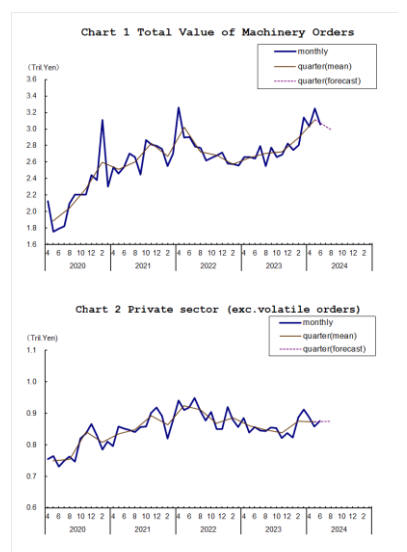
Companies report record profit – outlook uncertain
Japanese companies have just posted record quarterly
profits but the yen’s rebound is fueling worries about just
how sustainable their earnings growth will be amid weak
demand in China and the risk of a slowing US economy.
The outlook is uncertain, however, as the strengthening
yen will dent export growth.
Analysts estimate that each 1 yen appreciation in the
Japanese currency against the dollar could reduce profits
by up to 0.6%.
See:
https://www.japantimes.co.jp/business/2024/08/22/companies/ye
n-rise-hampers-japan-firm-growth/
Typhoon No.10 inflicts serious damage
Torrential rain in late August caused serious flooding in
many areas. The Meteorological Agency issued warnings
for Tokyo and surrounding areas as unstable atmospheric
conditions hit the region. Known colloquially in Japan as
‘guerrilla rainstorms’ these are localised heavy downpours
occurring suddenly and are difficult to predict.
At the end of August Japan was bracing for what is likely
to be the strongest typhoon to make landfall. Winds of up
to 250 km/hour were forecast and serious damage to
property has been reported.
Little change in consumer confidence index
The Cabinet Office has reported the seasonally adjusted
consumer confidence index was 36.7 in August, almost
unchanged from the previous month.
The income growth indicator was down to 39.7 while the
overall livelihood index moved up to 34.7. In contrast the
employment index weakened but the willingness to buy
durable goods rose slightly.
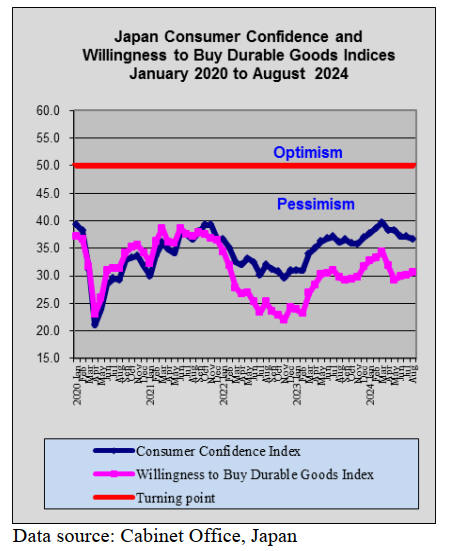
Yen appreciation continues
The yen appreciated in the last half of August driven by
hawkish sentiments by a variety of officials, some from
the Bank of Japan (BoJ). An additional factor could have
been the ‘safe-haven’ flows amid rising geopolitical
tensions.
See: https://www.fxstreet.com/news/japanese-yen-rises-due-to-
increasing-odds-of-a-further-boj-rate-hike-202408190401
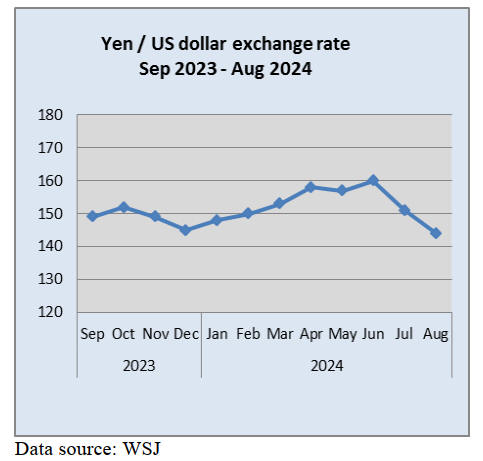
Suggestion of two more interest rate increases
In an interview the Head of Mizuho Financial Group Bank
suggested the Bank of Japan (BoJ) could hike interest rates
twice by the end of March 2025 to reach 0.5%, reflecting a
sustained growth in the Japanese economy. This would
have an impact on commercial bank lending rates and will
affect mortgage holders.
However, the Chief Executive Officer of Mizuho Bank is
repoted as saying “rate hikes won't be a tool to arrest the
weakening yen, which has plunged to a 38-year low
against the dollar,”
The BoJ ended negative interest rates after eight years in
March this year but there is no concensus amongst
analysts when another interest rate will be announced.
See: https://asia.nikkei.com/Business/Finance/Japanese-banks-
lending-rates-rise-for-7th-straight-month
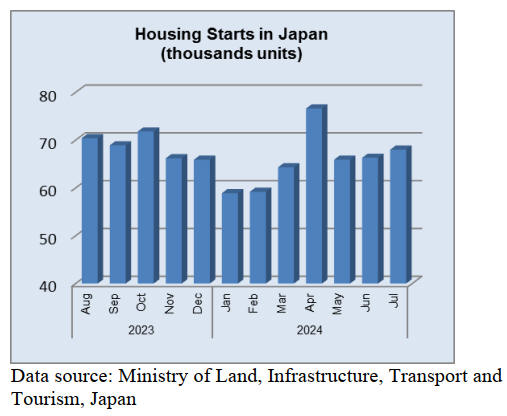
International Conference on African Development
Ministers from African nations and Japan meet in Tokyo
and pledged to collaborate on finding solutions to climate
change and other global challenges. Ministers and other
representatives from Japan and 47 of African’s 54
countries attended the meeting in Tokyo.
The Tokyo International Conference on African
Development concluded with the adoption of TICAD’s
first joint communique which also includes the need to
create a supportive environment for startups to promote
investment in Africa. The meeting served as a preparatory
step for the 9th TICAD summit scheduled to be held in
Yokohama next August.
See: https://www.mofa.go.jp/files/100715925.pdf
Import update
Assembled wooden flooring imports
After two consecutive monthly declines the value of
Japan’s wooden flooring (HS441871-79) imports rose
slightly in June but with the yen at around 115 to the US
dollar in June the uptick in imports was of little
significance. In the first quarter of this year the month on
month value of imports was rising faster than the pace of
yen depreciation signaling the import volumes were rising.
That changed in the second quarter.
Despite the erratic trend in the value of imports during the
first half of this year compared to June 2023 imports, the
performance in June 2024 was average and month on
month June 2024 imports were around 12% higher.
As in previous months the main category of assembled
flooring imports was HS441875, accounting for 76% of
the total value of assembled flooring imports, up from the
68% in May. The second largest category in terms of value
was HS441879 followed by HS 441874.
Shippers in China accounted for almost 70% of Japan’s
imports of assembled wooden flooring in June with
shippers in Vietnam accounting for another 15%. Of the
balance shippers in Thailand and Austria did well in June
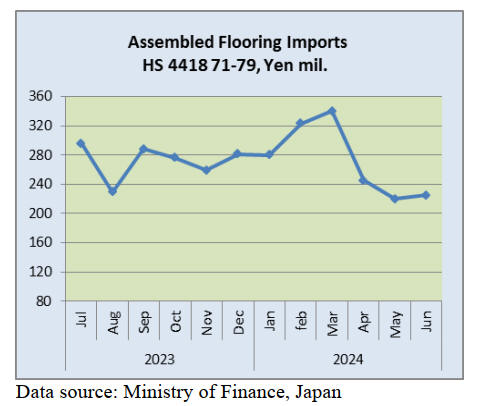
Plywood imports
Year on year, the volume of June plywood imports
(441210-39) was 121,846 cu.m up over 25% from the
volume recorded for June 2023 and month on month there
was an 12% increase in the volume of imports. Shippers in
Indonesia and China recorded a month on month increase
in volumes dispatched, June arrivals from Malaysia were
at around the same level as in May while shipments from
Vietnam dropped in June from a month earlier.
Of the various categories of plywood imported, 87%
was
HS441231 in June with HS441233 and HS441234 each
accounting for around 5% of the balance. The four main
shippers of plywood to Japan; Indonesia, Malaysia,
Vietnam and China consistently account for over 90% of
plywood imports. Other shippers appearing in Japan’s
plywood import statistics in June were Finland, Latvia,
Taiwan P.o.C and New Zealand.
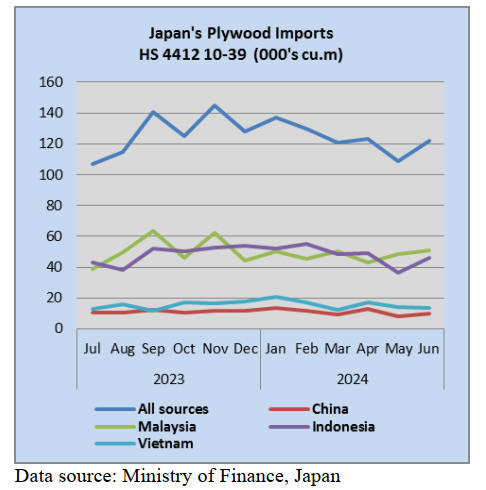
 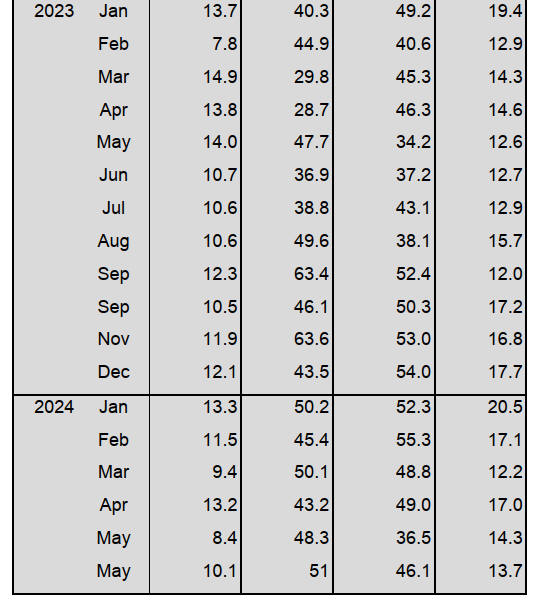
Trade news from the Japan Lumber Reports (JLR)
The Japan Lumber Reports (JLR), a subscription trade
journal published every two weeks in English, is
generously allowing the ITTO Tropical Timber Market
Report to reproduce news on the Japanese market
precisely as it appears in the JLR.
For the JLR report please see:
https://jfpj.jp/japan_lumber_reports/
Decline in price of PKS
The price of PKS (palm kernel shells) continues falling in
Indonesia. The spot price of authenticated Indonesian PKS
was US$136, FOB per tonne, in January, 2024. However,
the price declined to US$133, FOB per tonne, in February
2024 and declined to US$130, FOB per tonne, in March,
2024. In May, 2024, the price was USUS$119, FOB per
tonne. Then, the authenticated Indonesian PKS was
USUS$110 – 115, FOB per tonne, in June, 2024. Now, the
price is USUS$90 – 95, FOB per tonne.
A reason for a decline in the price of PKS is that huge
wooden biomass power plants, which consume imported
PKS or wooden pellets in Japan, postpone their operations
due to adjusting equipment. Moreover, there was a fire at
one of huge wooden biomass power plants and the
operation has been stopped. As a result, demand for PKS
has been stagnant.
There are not a lot of new orders for PKS because some
wooden biomass power plants get PKS from the inventory
in Japan or PKS from a demurrage vessel on the sea. In
Indonesia, it is the season to harvest palm oil and there are
a lot of PKS. There had been a concern about the third
party certification but auditing organizations have been
increased for the third party certification so the concern is
solved. Therefore, supply of authenticated PKS will
increase.
The spot price of wooden pellets in Vietnam is
USUS$120, FOB per tonne. This price has been
unchanged and this is the reason that the price of PKS has
not rose because calorie consumption of PKS is low.
North American logs
North American log and lumber markets are not good.
Douglas fir lumber manufacturers in Japan do not
purchase a lot of Douglas fir logs due to low demand.
The arrival volume of Douglas fir logs at the first half of
this year is 14.2 % less than the same period last year.
However, lumber manufacturers in Japan reduce
production so there is a certain amount of Doulgas fir logs
at distributors’ inventory. It is hard to predict that demand
for Douglas fir logs would recover or not. If the yen kept
appreciating against the US dollar in August, 2024, there
would be a possibility that Japanese buyers buy Doulgas
fir logs.
There are often fires occurring at mountains in North
America and there are concerns about a shortage of
Douglas fir logs. However, Japanese buyers still do not
order because Douglas fir logs due to low demand.
The orders to precutting companies in Japan have been
increasing in July and August, 2024. It seems that demand
for houses recovers slightly but it is not for sure because
there is no schedule to produce lumber after September,
2024. As a result, the precutting companies also do not
purchase a lot of North American logs. Consumers
stopped buying domestic small sized lumber instead of
Douglas fir small sized lumber. However, it is still
difficult to sell Douglas fir small sized lumber due to low
demand.
Some Japanese wholesalers expect that the purchasing cost
would decline because the yen appreciated against the US
dollar. However, the influence of strong yen would not be
big because the yen had depreciated widely. A recovery of
demand after September, 2024 would be the focus for
sales.
Radiata pine logs and lumber
Major Japanese wholesalers raised the price of Chilean
radiata pine lumber by 3,000 yen, FOB per cbm as of
August, 2024 because the yen was nearly 160 yen against
the US dollar.
The price of Chilean radiata pine thin board used to cost
around 57,000 yen, FOB per cbm and now it costs 60,000
yen in Kanto region. The price of Chilean radiata pine thin
board in Chubu region and Kinki region will be raised in
the future.
The import cost for NZ radiata pine logs shipped from NZ
to Japan in June, 2024 is high because the yen was nearly
160 yen against the US dollar and also the price of NZ
radiata pine logs in NZ was US$8, C&F per cbm
increased. The import cost is almost same as Chilean
lumber. However, the price of NZ radiata pine logs is
unchanged so far.
Demand for crating, which is made of radiata pine, is
lower than May, 2024 in July and August, 2024.
There was a long holiday in May, 2024.It is popular to use
recycled pallets as eco-friendly so consumption of lumber
is decreasing.
Plywood
Movement of domestic structural softwood plywood is not
good because the starts are decreasing. Some plywood
manufacturers and distributors offer to raise the price in
August, 2024 and there were last-minute requests for
plywood before the holiday in the middle of August.
The price of 12 mm 3 x 6 domestic structural softwood
plywood was around 1,180 yen at the end of July in Tokyo
metropolitan area.
Movement of imported South Sea plywood, especially
painted plywood for concrete form, is dull. The yen was
160 yen against the US dollar until the beginning of July
and the yen appreciated to around 146 yen at the end of
August. At the end of July, the price of 2.4 mm 3 x 6
plywood was raised by about US$10, C&F per cbm.
In South Asia, 12 mm 3 x 6 painted plywood for concrete
form is around US$600, C&F per cbm. Plywood form is
around US$510, C&F per cbm. Structural plywood is
around US$520, C&F per cbm. 2.4 mm 3 x 6 plywood is
around US$950, C&F per cbm. 3. 7is around US$880,
C&F per cbm. 5.2 mm is around US$850, C&F per cbm.
On the other hand, the price of South Sea plywood in
Japan is deadlocked now. In Tokyo metropolitan area, 2.5
mm plywood is 780 yen, delivered per sheet. 4 mm
plywood is 1,000 yen, delivered per sheet. 5.5 mm
plywood is 1,170 – 1,200 yen, delivered per sheet.
Structural plywood is 1,650 yen, delivered per sheet. 12
mm 3 x 6 painted plywood for concrete form is around
1,950 yen, delivered per sheet. Plywood form is 1,750 yen,
delivered per sheet.
South Sea log and products
A number of inquiries for South Sea lumber and Chinese
lumber has been increasing slightly. Demand is not a lot
but distributors have to purchase South Sea lumber or
Chinese lumber because they do not have enough
inventories. Some distributors purchased a certain amount
of South Sea lumber or Chinese lumber as the yen
appreciated to 140 yen against the US dollar.
There is a lot of inquiries for South Sea lumber to produce
truck bodies. Large laminated boards made of Chinese red
pine and of Indonesian Merkus pine are leveled off from
the previous month. The prices of South Sea and Chinese
lumber are unchanged from last month in Japan. Demand
and supply for South Sea logs are balanced. Demand for
blocks for steel and shipbuilding is stable and for truck
bodies is firm.
In Malaysia, plywood manufacturers have been reducing
production and there are not enough logs. The weather in
Papua New Guinea is bad so it is difficult to predict when
the logs will be collected enough.
Period for carrying out of logs extended
The Ministry of Agriculture, Forestry and Fisheries will
extend a period for carrying out standing trees which are
contracted to be carried out this yea, and this is to control
the supply of National Forest’s lumber. One year will be
extended for free. This is a precautionary measure for
eased demand and supply. Also, The Ministry of
Agriculture, Forestry and Fisheries launches the sales
system to control supplying logs in wide areas.
National Forest lumber occupies about 15 % of domestic
lumber supply. The Ministry of Agriculture, Forestry and
Fisheries supplies logs and standing trees and focuses on
controlling the supplying of standing trees this time.
Normally, the period for carrying out the standing trees is
three years and there will be a fine when it is overdue.
Buyers are able to decide about the fine.
To find a new way of supplying logs, The Ministry of
Agriculture, Forestry and Fisheries will launch a new
system at Regional Forest Office in Hokkaido Prefecture
and Tohoku region. A reason for launching a new system
is to help other areas’ Regional Forest Office, when its
demand and supply for logs were eased extremely.
An estimate of supply for logs in 2023 is 3,160,000 cbms,
13.3 % more than 2022 and for standing trees in 2023 is
1,840,000 cbms, 5.7 % more than 2022. Total supply for
logs and standing trees in 2023 were 5,000,000 cbms, 10.4
% up from the previous year.
Supply for logs in 2024 will be 3,430,000 cbms, 5.5 %
more than last year and for standing in this year will be
9,160,000 cbms, 2.1 % more than the previous year.
|